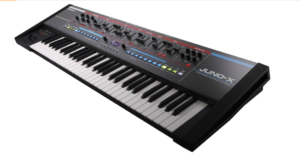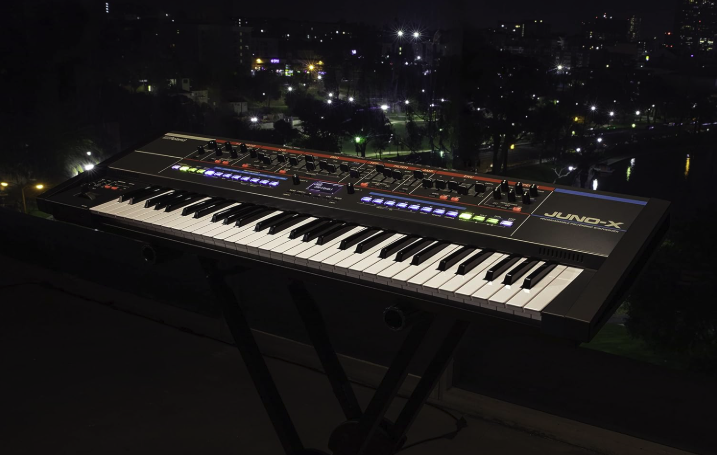Ever since I made this purchase a few months ago, I knew I had to write a Roland Juno X review. The Roland Juno X stands out as a significant release in Roland’s iconic Juno series. Known for their groundbreaking synths of the past, Roland combines the old with the new in this latest model. It’s both a nod to their legacy and a step forward for musicians seeking depth and variety.
release in Roland’s iconic Juno series. Known for their groundbreaking synths of the past, Roland combines the old with the new in this latest model. It’s both a nod to their legacy and a step forward for musicians seeking depth and variety.
This synth appeals to fans of analog sounds yet delivers the flexibility of digital tech. With its hybrid approach, the Juno X integrates advanced digital enhancements while maintaining the classic analog warmth that Juno synths are renowned for. Such a marriage of technologies isn’t just clever; it’s necessary for keeping pace in 2025’s rapidly evolving music scene.
The question often arises: why does the Juno X matter today? It’s simple – musicians are always chasing those classic tones and new sonic possibilities. The Juno X gives you that chance to explore deeply and innovate without losing touch with the roots that make synthesizers so beloved.
In a landscape crowded with digital solutions, the Juno X doesn’t just blend in. It steps up by providing both seasoned pros and enthusiastic newcomers with tools that inspire creativity. This isn’t just another synth; it’s a blend of history and future, a justification for its anticipation and buzz in the music world. Let’s dive further into this Roland Juno X review.
Discovering the Features that Define the Juno X
Roland Juno X is loaded with features catering to any musician looking to push boundaries. At its core, it boasts a powerful sound engine and impressive polyphony, making it a compelling choice for those aiming to create complex compositions without compromise.
One of the standout elements here is the combination of the SuperNATURAL engine and ZEN-Core technology. Together, they provide a wide scope of versatility, letting you capture everything from authentic vintage sounds to cutting-edge modern tones. This flexibility is key for anyone looking for a synth that adapts to varied styles.
Classic Juno aficionados will appreciate the inclusion of iconic sounds that built the series’ legend. But the Juno X doesn’t just replicate; it innovates, offering fresh capabilities that expand its sonic palette. Built-in arpeggiators and sequencers are part of what makes this synth a joy to play and explore, making intricate patterns and sequences attainable without needing extra gear.
Additionally, connectivity with Roland Cloud expands your library, ensuring the sounds available at your fingertips are practically limitless. This kind of integration means you’re never really hitting a creative ceiling—there’s always another sound, another tweak, another opportunity waiting.
For those wondering whether this range of features complicates learning, fear not. Despite its capabilities, the Juno X manages to pack all these elements into an intuitive interface that’s approachable for newcomers and fulfilling for seasoned synth users alike. It’s about making the most of tech without overwhelming the creative process.
Roland Juno X Review – Sound Quality Harnessing Vintage and Modern Sounds
The Roland Juno X impressively captures the essence of classic Juno models, particularly the revered Juno-60 and Juno-106. Its ability to authentically replicate these iconic tones ensures a nostalgic yet fresh listening experience.
You’ll find a broad array of sounds on offer. Lush pads create a rich, enveloping atmosphere, while the basslines can shake the room with their depth and power. Leads are sharp and present, perfectly suited for cutting through dense mixes. And don’t overlook the variety of effects; they add a professional sheen to any track.
Balancing the celebrated warmth of vintage gear with the adaptability of modern technology, the Juno X achieves a sonorous equilibrium. This fusion is crucial for musicians who desire both the character of old-school synths and the versatility required for today’s diverse music production needs.
When comparing it to other synthesizers in its range, the Juno X stands tall. While some synths offer retro sounds or modern capabilities, finding a unit that excels in both areas is rare—this is where the Juno X truly shines.
Whether you’re crafting a throwback tune or something that pushes the envelope, this synth is equipped to help you create full-bodied tracks that resonate with authenticity and innovation. It’s not just a tool; it’s a bridge between eras, empowering your music with its defining sound.
Crafting Artistry: Design and Build of the Juno X
The Roland Juno X is not just about what’s under the hood; its physical presence is equally impressive. It’s built with musicians in mind, ensuring durability and style are evenly matched.
At a glance, the Juno X boasts a robust yet manageable size that won’t overwhelm your studio space or stage setup. Its weight is well-distributed, making it sturdy enough for live performances while still being portable.
A closer look at the user interface reveals a thoughtfully designed layout that simplifies your creative process. The knobs, sliders, and buttons are intuitively placed, allowing for quick adjustments and real-time sound shaping. This accessibility enhances workflow, vital for those spontaneous sessions where inspiration hits unexpectedly.
Navigation through its features is a breeze, making it suitable for users at any experience level. The layout isn’t cluttered or intimidating; it invites exploration and hands-on engagement.
Visually, the Juno X pays homage to its retro roots, merging nostalgic design elements with sleek modern aesthetics. It feels familiar yet looks forward-thinking, which can be a significant draw for creatives who value both heritage and innovation in their tools.
Roland Juno X Review – In the Studio: A Personal User Experience with the Juno X
Opening the box of the Roland Juno X, I was immediately struck by the care put into every detail. Setting it up was straightforward, and the build quality assured me it was crafted for serious use.
The first session with the Juno X was about exploration. Navigating through its various features felt instinctive. The simplicity of accessing the arpeggiator or tweaking the integrated sequencer was a testament to its user-friendly design.
What grabbed my attention was the range of sounds at my disposal. From the beginning, creating patches was engaging, allowing for both spontaneous creativity and methodical design. The presets offered a solid foundation, but the true joy came from molding them to fit unique artistic needs.
Integrating the Juno X into my existing studio setup was seamless. It complemented other synths and effortlessly synced with the digital audio workstation. Its ability to transition from studio work to a live rig was another highlight, showcasing its versatility.
I remember crafting a track that leaned heavily on the classic Juno warmth, yet it was punctuated with modern twists thanks to the Juno X’s advanced features. It was a session that highlighted the synth’s role in shaping innovative soundscapes.
Occasionally, learning curves came up—such as familiarizing myself with its full range of effects—but these were minor hurdles. The more I played, the more the Juno X revealed its potential, proving its worth as a limitless creative partner.
Assessing Performance, Audience Fit, and Overall Value
For anyone contemplating the Juno X, its ease of use is a standout benefit. From the initial setup to patch creation, everything feels logical and encouraging of experimentation, making it suitable for varied experience levels.
In live performance settings, the Juno X holds its own. It’s robust, reliable, and provides quick access to a multitude of sounds, all essential for gigging musicians who need consistency on stage.
In the studio, its role integrates seamlessly. Whether part of a larger production workflow or the centerpiece of your setup, the Juno X is designed to bridge traditional sound with modern production needs efficiently.
When considering the ideal users, professional musicians and producers will find a lot to love. Its depth and range appeal to those who demand more from their instruments. Synth enthusiasts looking for both classic and contemporary sounds will also find it rewarding, as will beginners keen to explore an all-in-one synth.
Evaluating its overall value, the Juno X’s price may be a consideration. However, given its comprehensive feature set and ability to accommodate various musical styles and needs, it represents a sound investment for those serious about their craft. Its capacity to grow with you as your skills and projects expand makes it a worthy addition to any musician’s arsenal.
I appreciate your taking the time to read my Roland Juno X review. I am thoroughly in love with this keyboard; it looks as good in my studio as it sounds. Should you decide to purchase one, I think you’ll be very happy with it too. Thanks for reading.



